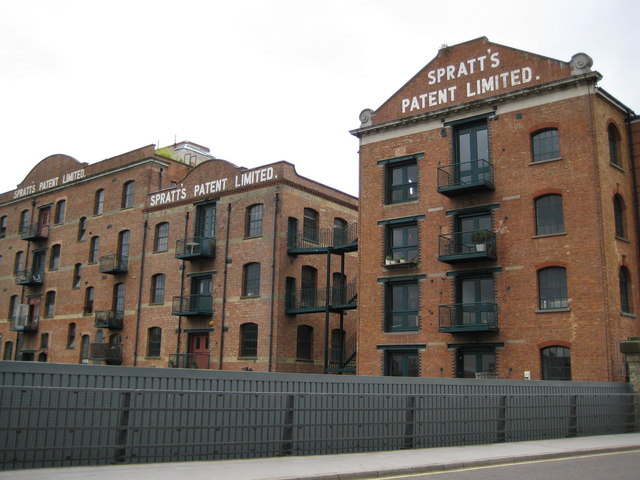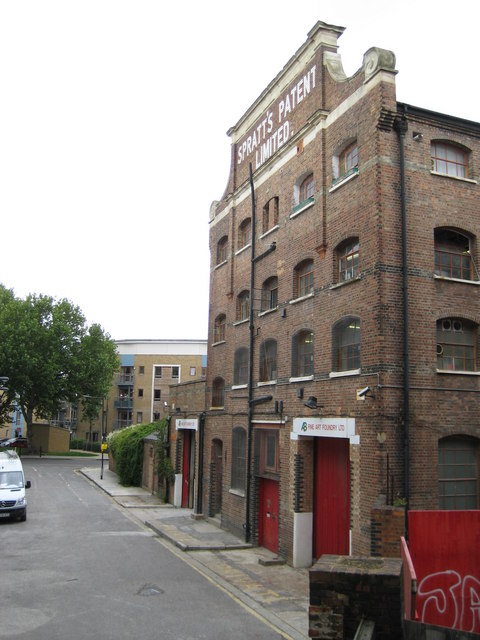Spratt's Complex on:
[Wikipedia]
[Google]
[Amazon]
 Spratt's Complex is a housing development in
Spratt's Complex is a housing development in  The complex, which once operated as
The complex, which once operated as
 The complex was split into studio workshops (live/work units) and sold by JJAK (Construction) Ltd as empty shells for leaseholders to fit out. The first building to be converted was Limehouse Cut. The studio sizes vary between . The building was featured in the ''Sunday Times'' in June 1986 and again in 1989. Back in 1986, the studio - "part workplace, part home" - had no status in planning law. At that time, residents of the building included the Queen's tapestry restorer Ksynia Marko, a packaging firm, Roger Law of ''
The complex was split into studio workshops (live/work units) and sold by JJAK (Construction) Ltd as empty shells for leaseholders to fit out. The first building to be converted was Limehouse Cut. The studio sizes vary between . The building was featured in the ''Sunday Times'' in June 1986 and again in 1989. Back in 1986, the studio - "part workplace, part home" - had no status in planning law. At that time, residents of the building included the Queen's tapestry restorer Ksynia Marko, a packaging firm, Roger Law of ''
 The building is now a series of "live/work units" used by artists, designers and architects, and other creative professions.
The building is now a series of "live/work units" used by artists, designers and architects, and other creative professions.
 At the top of Limehouse Cut building is a large communal roof garden with views over Canary Wharf. It is private and maintained by volunteering residents.
On 8 October 2008, the Langdon Park conservation area was extended to include the Spratt's Complex.
At the top of Limehouse Cut building is a large communal roof garden with views over Canary Wharf. It is private and maintained by volunteering residents.
On 8 October 2008, the Langdon Park conservation area was extended to include the Spratt's Complex.
 Spratt's Complex is a housing development in
Spratt's Complex is a housing development in Poplar, London
Poplar is a district in East London, England, the administrative centre of the borough of Tower Hamlets. Five miles (8 km) east of Charing Cross, it is part of the East End.
It is identified as a major district centre in the London Plan ...
. The former pet food factory was converted into approximately 150 live-work units beginning in 1985. This was one of the first such warehouse conversions in London. The complex is on Morris Road, lining Limehouse Cut
The Limehouse Cut is a largely straight, broad canal in the East End of London which links the lower reaches of the Lee Navigation to the River Thames. Opening on 17 September 1770, and widened for two-way traffic by 1777, it is the oldest can ...
canal, and is situated between the DLR stations of Langdon Park Langdon Park may refer to:
*Langdon, Washington, D.C., an area of Washington, D.C. in the United States
*Langdon Park DLR station, a Docklands Light Railway station in Poplar, London, United Kingdom
*Langdon Park School
Langdon Park School is a ...
and Devons Road.
 The complex, which once operated as
The complex, which once operated as Spratt's
Spratt's was the world's first large-scale manufacturer of dog biscuits. The company successfully promoted their array of products for dogs and other domestic animals through the astute use of snob appeal. The company was the first to erect a bill ...
dog biscuit factory, consists of six multi-story warehouses
A warehouse is a building for storing goods. Warehouses are used by manufacturers, importers, exporters, wholesalers, transport businesses, customs, etc. They are usually large plain buildings in industrial parks on the outskirts of cities, town ...
made of reinforced concrete grouped around courtyards. Much of the original factory markings and lettering are visible on the buildings, painted on the DLR track-side walls and also on the small chimney visible from Morris Road. The complex is also locally known as "Spratt's Works" or "Spratt's Factory".
History
The Spratt's Works (1899-1969)
The factory was built prior to 1899, possibly as early as 1860 according to the deeds of some residents, though the architecture suggests construction took place some decades later. In the early 20th century, the Spratt's Works was the largest dog food factory in the world. The building now known as Colman's Wharf was originally a seed, packing, grain warehouse. Limehouse Cut was once a series of grain warehouses, along with buildings for meal grinding, sand and grit processing, baking, veterinary medicine and laboratory stores. Foundry House was once a power house, as well as a bakery, bank and delivery warehouse. Patent House was originally a delivery and grain warehouse, with space for biscuit packing, a blacksmiths and wire workers, saw mills, kennel and box makers, and an advertising department. One Fawe Street was historically a grain warehouse, flour warehouse and bakery. James Spratt set up his business in 1860 and soon his business was a "howling success". The location along Limehouse Cut allowed barges to easily deliver fish heads and other supplies to the factory for processing. The company was not restricted to dog biscuits: in theSecond Boer War
The Second Boer War ( af, Tweede Vryheidsoorlog, , 11 October 189931 May 1902), also known as the Boer War, the Anglo–Boer War, or the South African War, was a conflict fought between the British Empire and the two Boer Republics (the So ...
(1899–1902), four million ship's biscuits a week were made for the British Army
The British Army is the principal land warfare force of the United Kingdom, a part of the British Armed Forces along with the Royal Navy and the Royal Air Force. , the British Army comprises 79,380 regular full-time personnel, 4,090 Gurkha ...
. Before 1914, the factory made other food for human consumption under the "Poplar" brand, such as pulses
In medicine, a pulse represents the tactile arterial palpation of the cardiac cycle (heartbeat) by trained fingertips. The pulse may be palpated in any place that allows an artery to be compressed near the surface of the body, such as at the nec ...
(butter beans, lentils, and peas), and did international trade in live animals (horses, foxes, and monkeys).
According to the ''East London News'', in World War II
World War II or the Second World War, often abbreviated as WWII or WW2, was a world war that lasted from 1939 to 1945. It involved the World War II by country, vast majority of the world's countries—including all of the great power ...
, the Morris Road facilities "suffered severe damage as a result of enemy air action" and "the damage to the factory and working machinery made it almost impossible to carry on the work". By the end of the war "the impression of inscrutability conveyed by the gaunt impressive is cancelled out by the feverish activity inside." Besides biscuits, Spratt's Works was also producing dogs', cats' and birds' medicines, bird seed, dog shampoos, and toilet requisites for animals. There was also a dog-show department during this period, possibly owing to James Spratt's initial 14-year-old assistant, the future dog show founder Charles Cruft.
After the imposition of purchase tax on pet food in 1969, the factory closed down.
The derelict years (1970-1985)
The warehouses were derelict for some years until they were redeveloped between 1985 and 1989. As local lore has it, dog fighting took place years ago in the basement. The Foundry House was derelict, with tape left on the windows fromThe Blitz
The Blitz was a German bombing campaign against the United Kingdom in 1940 and 1941, during the Second World War. The term was first used by the British press and originated from the term , the German word meaning 'lightning war'.
The Germa ...
and great globs of toffee on the floors left by Appleton's (wholesale confectioners who had occupied the building after Spratt's). Originally, the courtyard was cobbled throughout.
Colman's Wharf was occupied by Gina Plastics until sold for development in 1988, at which time there was a huge industrial bay outside Studio5, on what is now part of the car park. The space at the canal end of the floors of Colman's Wharf was much larger than now, as there was no interior staircase, nor was the present lift shaft part of the building, as large hoists were in use before its development. The ceilings had huge grid works of iron sprinkler pipes complete with large taps and fixings, and the doors that now open onto balconies and those overlooking the canal were of the stable door type, glazed in the upper part and solid in the lower part. The windows are original except for some of those in studios on the third floor facing the City.
The conversion project (1985-1989)
 The complex was split into studio workshops (live/work units) and sold by JJAK (Construction) Ltd as empty shells for leaseholders to fit out. The first building to be converted was Limehouse Cut. The studio sizes vary between . The building was featured in the ''Sunday Times'' in June 1986 and again in 1989. Back in 1986, the studio - "part workplace, part home" - had no status in planning law. At that time, residents of the building included the Queen's tapestry restorer Ksynia Marko, a packaging firm, Roger Law of ''
The complex was split into studio workshops (live/work units) and sold by JJAK (Construction) Ltd as empty shells for leaseholders to fit out. The first building to be converted was Limehouse Cut. The studio sizes vary between . The building was featured in the ''Sunday Times'' in June 1986 and again in 1989. Back in 1986, the studio - "part workplace, part home" - had no status in planning law. At that time, residents of the building included the Queen's tapestry restorer Ksynia Marko, a packaging firm, Roger Law of ''Spitting Image
''Spitting Image'' is a television in the United Kingdom, British satire, satirical television puppet show, created by Peter Fluck, Roger Law and Martin Lambie-Nairn. First broadcast in 1984, the series was produced by 'Spitting Image Productio ...
'', sculptor Michael Green and ceramicist Elizabeth Fritsch.
Originally, the planning permission and the lease restricted the residential accommodation to no more than 50% of the space, with the rest having to be used for business. In the 1990s, as it became progressively more difficult to get mortgages for properties of this type, the majority of the units were changed to allow 100% residential use. Each unit was originally sold as a shell with utilities run at the entrance of the unit (water, drainage, electricity, gas, telephone and fax lines, TV aerial and entry phone cables). It was up to the leaseholder to design and fit out their own unit, including partitions, pipes and wiring. Building regulations required each unit to include a fire lobby.
Today
 The building is now a series of "live/work units" used by artists, designers and architects, and other creative professions.
The building is now a series of "live/work units" used by artists, designers and architects, and other creative professions.
 At the top of Limehouse Cut building is a large communal roof garden with views over Canary Wharf. It is private and maintained by volunteering residents.
On 8 October 2008, the Langdon Park conservation area was extended to include the Spratt's Complex.
At the top of Limehouse Cut building is a large communal roof garden with views over Canary Wharf. It is private and maintained by volunteering residents.
On 8 October 2008, the Langdon Park conservation area was extended to include the Spratt's Complex.
Notes
References
{{coord, 51.518454, -0.016034, region:GB, format=dms, display=title Buildings and structures in the London Borough of Tower Hamlets Residential buildings in London Gated communities in the United Kingdom Poplar, London